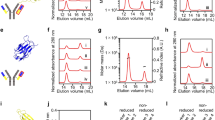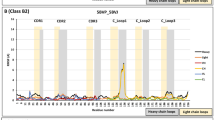Abstract
THE dimer of immunoglobulin light chains (L2) was shown by X-ray crystallography to be structurally homologous to the native immunoglobulin Fab fragment (HL) (refs 1–3). This led to the suggestion that L2 is a model for a primitive antibody1 and for the T-cell receptor22,23. In L2 315 (from the mouse myeloma protein MOPC 215) functional homology was also implicated in that both L2 and HL bind the same nitroaromatic haptens with similar fine specificity4,5. We have considered the possibility that this homology extends also to hapten-induced conformational changes and that studies with L2 will yield information on the nature of such processes in immunoglobulins. L2 315 constitutes a particularly good model system for such studies as it binds two hapten molecules per dimer at symmetry-related sites4,5. It is thus possible to monitor the conformational effects of the first binding hapten through the mode of interaction with the second, as revealed by the shape of the saturation curve6. We report here that dinitrophenyl-lysine (DNPL) and its fluorescent analogue nitrobenzoxadiazole-alanine (NBDA) (ref. 7) both display sigmoidal binding curves, implying positive cooperativity in their interaction with L2 315. This observed cooperativity is shown to arise from a hapten-induced conformational transition which may be described by the allosteric model6. We propose that this allosteric transition involves changes in the relative position of the chains in L2, lending support to suggestions8,9 that a similar process occurs in the structurally homologous intact immunoglobulin. These findings are, therefore, relevant to the question of antigen-triggered effector functions of antibodies through an allosteric mechanism8,10–12.
This is a preview of subscription content, access via your institution
Access options
Subscribe to this journal
Receive 51 print issues and online access
$199.00 per year
only $3.90 per issue
Buy this article
- Purchase on Springer Link
- Instant access to full article PDF
Prices may be subject to local taxes which are calculated during checkout
Similar content being viewed by others
References
Edmundson, A. B. et al. Biochemistry 13, 3816–3827 (1974).
Edmundson, A. B., Ely, K. R., Abola, E. E., Schiffer, M. & Panagiotopoulos, N. Biochemistry 14, 3953–3961 (1976).
Edmundson, A. B. et al. in Antibodies in Human Diagnosis and Therapy (eds Haber, E. & Krause, R. M.) (Raven, New York 1977).
Schechter, I., Ziv, E. & Licht, A. Biochemistry 15, 2785–2790(1976).
Licht, A., Lancet, D., Schechter I. & Pecht, I. FEBS Lett. 78, 211–215 (1977).
Monod, J., Wyman, J. & Changeux, J. T. J. molec. Biol. 12, 88–118 (1965).
Lancet, D. & Pecht, I. Biochemistry (in the press).
Schlessinger, J., Steinberg, I. Z., Givol, D., Hochman, J. & Pecht, I. Proc. natn. Acad. Sci. U.S.A. 72, 2775–2779 (1975).
Poljak, R. J., Amzel, L. M. & Phizackerley, R. P. Prog. Biophys. molec. Biol. 31, 67–93 (1976).
Metzger, H. Adv. Immun. 18, 169–207 (1974).
Huber, R., Deisenhofer, J., Colman, P., Matsuchima, M. & Palm, W. Nature 264, 415–420(1976).
Lancet, D. & Pecht, I. Proc. natn. Acad. Sci. U.S.A. 73, 3549–3553 (1976).
Adair, G. S. J. biol. Chem. 63, 529(1925).
Levitzki, A. in Subunit Enzymes; Biochemistry and Function (ed. Ebner, K. E.) (Marcel Dekker, New York, 1975).
Levitzki, A. & Schlessinger, J. Biochemistry 13, 5214–5219(1974).
Stevenson, G. T. Biochem. J. 133, 827–836(1973).
Cathou, R. E., Dorrington, K. J. in Subunits in Biological Systems, part C(eds Timasheff, S. N. & Fasman, G. D.) (Marcel Dekker, New York, 1975).
Padlan, E. A., Davies, D. R., Pecht, I., Givol, D. & Wright, C. Cold Spring Harb. Symp. quant. Biol. XLI, 627–637 (1977).
Cathou, R. E. & Werner, T. C. Biochemistry 9, 3149–3155(1970).
Pecht, I. & Lancet, D. in Chemical Relaxation in Molecular Biology (eds Pecht, I. & Rigler, R.) (Springer, Heidelberg, 1977).
Powell, M. J. D. in Harwell Subroutine Library (ed. Hopper, K. J.) (Subroutine VA04A Atomic energy Research Establishement, Harwell).
Janeway, C. A., Jr, Wigzell, H. & Binz, H. Scand. J. Immun. 5, 993–1001 (1976).
Krawinkel, U. et al. Cold Spring Harb. Symp. quant. Biol. 41, 285–294 (1977).
Author information
Authors and Affiliations
Rights and permissions
About this article
Cite this article
LANCET, D., LICHT, A., SCHECHTER, I. et al. Hapten-induced allosteric transition in the light chain dimer of an immunoglobulin. Nature 269, 827–829 (1977). https://doi.org/10.1038/269827a0
Received:
Accepted:
Issue Date:
DOI: https://doi.org/10.1038/269827a0
Comments
By submitting a comment you agree to abide by our Terms and Community Guidelines. If you find something abusive or that does not comply with our terms or guidelines please flag it as inappropriate.



